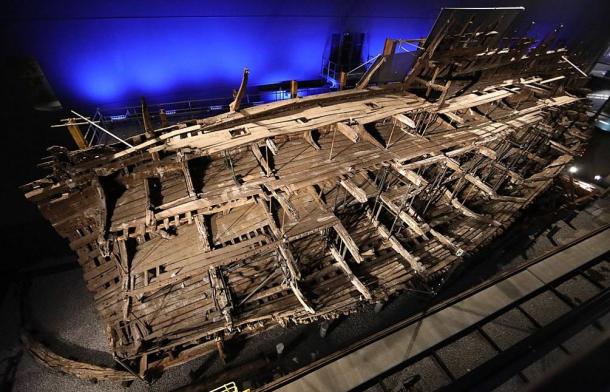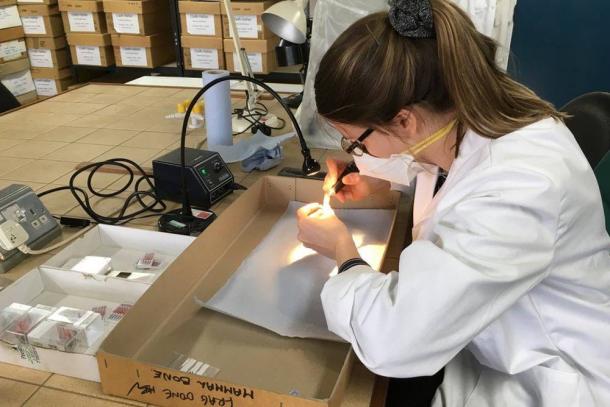A team of researchers in England have analyzed the teeth of eight crewmen recovered from King Henry VIII’s sunken ghost ship, the Mary Rose. Not only have the crew been dubbed a “multicultural” bunch, but the new research has even taken a stab at identifying each of their professions.
The Mary Rose was the famous carrack-type warship of King Henry VIII , known as the pride of the English Tudor navy. Over 33 years, the gallant oceanic war platform fought in several wars against France and Scotland and she was mostly rebuilt in 1536 AD. The Mary Rose served the crown of England for the last time on 19 July 1545 when, after attacking a French invasion fleet during the Battle of the Solent, she sank in the straits to the north of England’s the Isle of Wight.
Bringing the Mary Rose Crew Ghosts Back to Life
A new study by researchers from Cardiff University was recently published in the journal Royal Society Open Science , and it presents a detailed, and fascinating, analysis of the teeth of eight crew members who served on England’s most famous historic English warship. According to the Daily Mail , the conclusions of the new study suggest the favorite ship of King Henry VIII was a “multinational crew” comprising a mixed crew of Europeans and North Africans.

The remains of the Mary Rose shipwreck, where the Mary Rose crew remains were discovered. (Geni / CC BY-SA 4.0 )
After 437 years lying on the murky-dark in the sea of the south coast of England, in 1982 the remains of the Mary Rose and her 19,000 artifacts were recovered. She is now displayed in Portsmouth Historic Dockyard . Dr. Alexzandra Hildred, from the Mary Rose Trust , said that over the years a number of artifacts recovered from the wreck were found that “were not” manufactured by English craftspeople, a discovery which led archaeologists to consider that perhaps some of the crew were foreign.

As part of the study of the study of the remains of eight members of the Mary Rose crew, researchers have examined their bones to try to reconstruct their biographies. ( Cardiff University )
Mapping the Genetic Origins of Eight Tudor Sea Warriors
The unpredictable result of the ship’s crew having “diverse backgrounds” was arrived at through a technique called multi-isotope analysis, which analyzed the genetic composition of the inner-teeth, and the calculus on their surface of the teeth of eight crew members who perished on the ship in 1545. The study of the crew’s teeth revealed hitherto locked data about their childhood diets, which in turn helped determine their geographical origins.
Three of the eight crew originated from warmer southerly climates, with the other five having come from the west of Britain. Lead author of the new paper, Dr. Jessica Scorrer, concludes that the British navy drafted its crew from “a diverse range of backgrounds” during the Tudor period. What this means, according to the researchers, is an advancement in the “ever-growing body of evidence for diversity in geographic origins, ancestry and lived experiences in Tudor England.”
Identifying Tudor Period Trades of the Mary Rose Crew
Co-author of the new study, Dr. Richard Madgwick, explained that by combining the latest scientific methods with insights from artifacts recovered from the ship, they were able to reconstruct the biographies of the eight people from the Tudor period. The “suspected” professional trades associated with each of the eight men were “a cook, a mariner, a Royal Archer, an Archer, a Carpenter, an Officer, a Gentleman and a Purser.”
It should be added, however, that these professional attributions were not deduced primarily from the study of the teeth, but from the context in which each of the eight Mary Rose crew members were found. The researchers warn that this aspect of the study is “by no means certain as the material could have been displaced” over almost 500 years.
Putting the Mary Rose Crew Study into Context
To put this issue into context, have you ever considered what archaeologists would say about you if they hauled you up after 500 years underwater and analyzed your gnashers? Speaking personally, in my “multi-isotope analysis” results researchers from the future would see fresh potatoes, cabbage and hormone-free beef which would lead the team to conclude that I was brought up in Britain in the 1970s. However, an assistant might knock on the lab door and might say “sir, we just identified a lot of Iron-Bru in the molars,” which would help them determine that I was Scottish! What about you? What would your teeth say about your childhood?
Top image: The Mary Rose depicted on the Anthony Roll of Henry VIII’s Navy (1546), an illustrated inventory of King Henry VIII’s navy. The remains of members of the Mary Rose crew have been analyzed in this new study. Source: Public domain
By Ashley Cowie
 RSS Feed
RSS Feed















 May 7th, 2021
May 7th, 2021  Awake Goy
Awake Goy  Posted in
Posted in  Tags:
Tags: 













